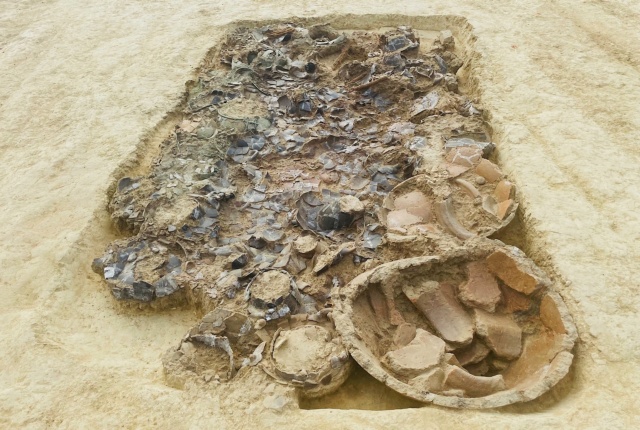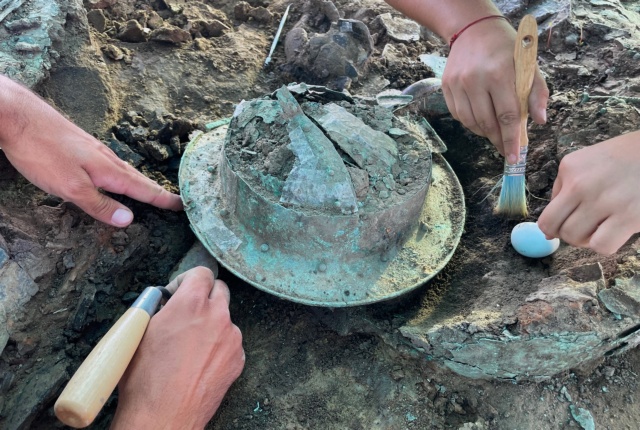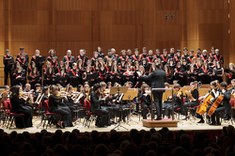A new Picene princely tomb from Corinaldo

A new princely tomb attributable to the Picene culture – dating back to the 7th century B.C. – emerged from the ground of Contrada Nevola, in Corinaldo (in the Ancona province), thanks to an excavation campaign led by the University of Bologna. Archaeologists revealed a large quadrangular pit (approximately 3.80 by 2.20 metres), which was itself located in a large circular ditch with an original diameter of 30 metres. Inside the pit, more than 150 objects have been found, including a two-wheeled chariot and a prestigious set of bronze artifacts comprising a helmet, a cauldron, and several finely decorated containers.
"The collection of artifacts clearly points to the realm of banqueting, as indicated by a bundle of spits and an iron axe for meat preparation, as well as a substantial amount of pottery to contain and serve foods and drinks. In addition, it also portrays the character, commemorated as a figure of the highest status", explains Federica Boschi, Professor at the Department of History and Cultures of the University of Bologna, who is leading the excavation. "Several objects originated from the Etruscan world, with which the Picene aristocracy of the time maintained exchanges and relationships".
The findings are part of the ArcheoNevola Project, which the University of Bologna launched in 2018 in collaboration with the Corinaldo Municipality and in agreement with the Soprintendenza Archeologia, Belle Arti e Paesaggio (Archaeological, beautiful arts and landscape Superintendence) for the provinces of Ancona and Pesaro Urbino. A few years ago, the project had already uncovered a Picene burial equipped with a rich set of grave goods, known as ‘the Prince of Corinaldo’s’.
From the beginning, the ArcheoNevola project has been using non-invasive investigation methods, especially geophysics and aerial photography. Not only did these lead to the discovery of the site, but they also allowed the team to obtain a detailed knowledge of the buried archaeological heritage (its extent, structure and main characteristics). Over the years, it has thus been possible to plan excavation campaigns with a fairly precise idea of what might emerge from the ground. In 2024, the researchers knew that the sector of the necropolis in question was very promising.
"The investigations carried out so far outlined the presence of a large necropolis dating back to the 7th century B.C., later reoccupied during the Roman period up to the end of the 3rd century A.D. The oldest funerary core is linked to the peak phase of the Picene culture – around the mid-7th century – with funerary monuments bordered by large circular ditches", says Boschi. "Starting from the 1st-2nd century A.D., a large Roman-era burial ground developed on the outskirts of the original monumental site. This continuity highlights the area’s significance a place rich in memory and meaning".
Excavation campaigns are organised with the support of the Corinaldo Municipality and the contribution of AlmaScavi, and they are carried out each year for about a month. Excavations involve many archaeology students of the University of Bologna, enrolled in various degree programmes, from the Bachelor’s in Humanities, in History and in Cultural Heritage, to the Master’s in Archaeology and Culture of the Ancient World and in Artistic and Archaeological Heritage and Landscape, up to the Specialisation School in Archaeological Heritage and the PhD programme.
"Research activities will proceed in the following months, and students will continue to be involved", added Boschi. "In fact, we have planned new territorial investigations with geophysical surveys, drone overflights and surface reconnaissance, as well as outreach activities for the local community and the public".
Over the years, the ArcheoNevola project carried out important collaborations both within and outside the University of Bologna. Among these, the most relevant ones are with the following institutions: the Department of Cultural Heritage and its DNALab, the single cycle degree programme in Conservation and Restoration of Cultural Heritage (Ravenna Campus), the Department of Industrial Engineering, the Flaminia Foundation, the National Institute of Geophysics and Vulcanology (INGV), the Laboratory of Anthropology and Forensic Odontology (University of Milan), the Restoration Laboratory of the CivicArchaeological Museum of Castelleone di Suasa, the Geocarta enterprise (France).






